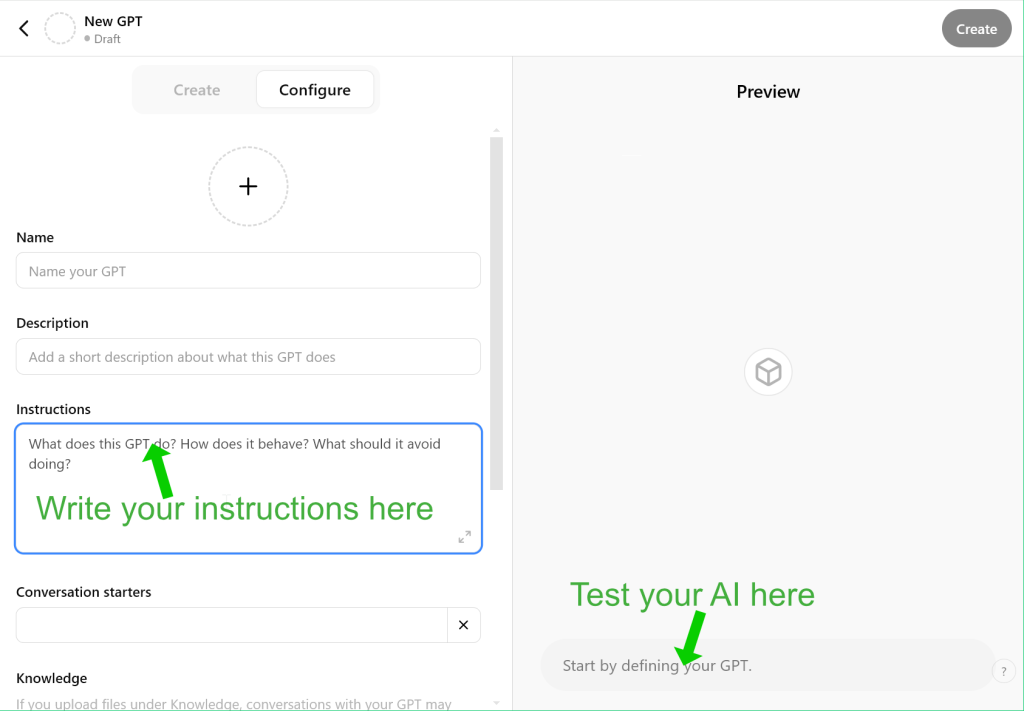It seems that AI is highly complex with huge budgets being spent. It’s not hype – it actually works – but many people are scared of building their own, even though it’s easy (and essential to staying ahead). You can have a working version up and running – with no prior tech knowledge – in less than a minute.
This guide will walk you through the essentials of creating a CustomGPT that’s both powerful and useful. You don’t need to be a tech expert to succeed—just open-minded and willing to experiment. Let’s explore the core concepts and techniques to make AI work for you.
Core Concept: The CustomGPT
OpenAI – the company that created and owns ChatGPT – created a free-to-use service called ‘Custom GPTs’ that enables anyone to instantly create a custom-AI tuned for their specific needs, and run it immediately without delay or payment. I have a dedicated page of resources on designing, using, and leveraging CustomGPTs.
Preparation: Steps to create an OpenAI account
- Create an OpenAI account at https://openai.com/chatgpt/
- Subscribe to the ‘GPT+’ product (currently $20/month: https://openai.com/chatgpt/pricing/) so you can create new CustomGPTs
- NOTE: the CustomGPTs you create can be used by anyone, for free – they won’t need a GPT+ account, just a basic (free) account. You only have to subscribe so you can create CustomGPTs
- Visit https://chatgpt.com/create to create your first CustomGPT
Total time: < 1 minute (create account, add credit-card, login)
Creation: Steps to create your Custom AI
As above, start by logging in and going to: https://chatgpt.com/create

You can ignore everything except the “Instructions” box on the left, and the “testing area” on the right.
Steps:
- Describe what you want the AI to do for you in the Instructions box – use some of my pre-written examples on the CustomGPTs page, or go with the simplest: “Tell a joke”
- Move your mouse cursor to the right-hand side and it will show a wait cursor, or ‘updating’ for a few seconds while it prepares the AI – this is often instant, but can take up to 4-5 seconds if the servers are busy
- When it lets you type in the right hand side, write anything at all in the ‘Message GPT’ box and hit enter, e.g. the simplest: “Go” – the AI will respond based on the instructions you gave
- Iterate/improve it: change your instructions, e.g. “Tell me a green joke”
- … and then type “Go” in the right hand side again – see how the AI has already been replaced with the new one.
There is one more thing to consider – after you’ve improved and tweaked your new AI (read the steps below for pointers and advice on making it not just good but great) – if you want to share with coworkers or friends you’ll need to Publish it.
Total time: 1-10 minutes (write instructions, experiment)
Steps to publish a Custom GPT
- From the editing interface, in the top right corner hit the ‘Create’ button (you’ll need to have given it a name etc first)
- You have multiple options, but only the “Everyone on ChatGPT Store” will make it fully public, and free, for everyone
- “Private” (will restrict usage only to people you give access to; they may need a paid account)
- “Everyone on the ChatGPT store” (will make it available to anyone, for free)
- Share the link it gives you on X/Facebook/Email etc
Now: go play with it for a bit. Read my Guide to CustomGPTs for quick tips on a successful AI, and for more extensive tips and techniques once you’re feeling confident.
Total time: 15 seconds (click Create, choose privacy, share link)
Here’s a few essential tips to get started…
Quick Tips for Writing Effective Custom GPTs
1. Start with a ‘stream of consciousness’
Don’t over-think it – AI/GPTs are exceptionally good at ‘reading between the lines’ and ‘inferring your intent’ – this is tied to how they work internally, it’s a core feature!
You can literally just put down your thoughts – un-edited – straight into the ‘Instructions’ box, without formatting, and with spelling mistakes etc – and often it will work perfectly. This is a great way to work, even when you’re an expert: it’s faster than planning in detail, and it preserves the essence of what you wanted better than if you over-thought it.
2. Inspire, don’t Instruct
The core design of LLMs means that current AIs are literally incapable of following instructions. If you give them instructions they will (behind the scenes) interpret them as “inspiration” rather than “rules / demands” – and it risks derailing their thought-process. It also leads to confusion and disappointment for yourself as the AI appears to ‘disobey’ what you told it to do.
Instead: focus on ‘framing the question’, providing context, and motivation – then let the AI figure-out both ‘what’ and ‘how’ to deliver that.
3. Embrace hallucinations
Most of what’s written about AI Hallucinations is misleading at best, or worse: plain wrong. You’ll quickly discover the truth yourself: the hallucinations are a positive, not a negative. For more detail on this – and how to benefit from it – read my [advanced CustomGPT tips], but for now simply remember: if it hallucinates once, re-start the conversation; if it hallucinates multiple times in a row: re-think the phrasing of your problem/task.
Ready to get started?
If you haven’t already … go write your first CustomGPT! Recap:
- Use the examples on the CustomGPTs page linked earlier, or just: “Tell me a joke”
- Create an OpenAI account using the steps at the top of this page
- Create a CustomGPT using the steps at the top of this page
- If you like it – publish it! (and send me a link – I’d like to see what you’ve created!
Go ahead, create your CustomGPT. Let the AI take the lead, and watch how quickly it becomes an invaluable tool in your organization.